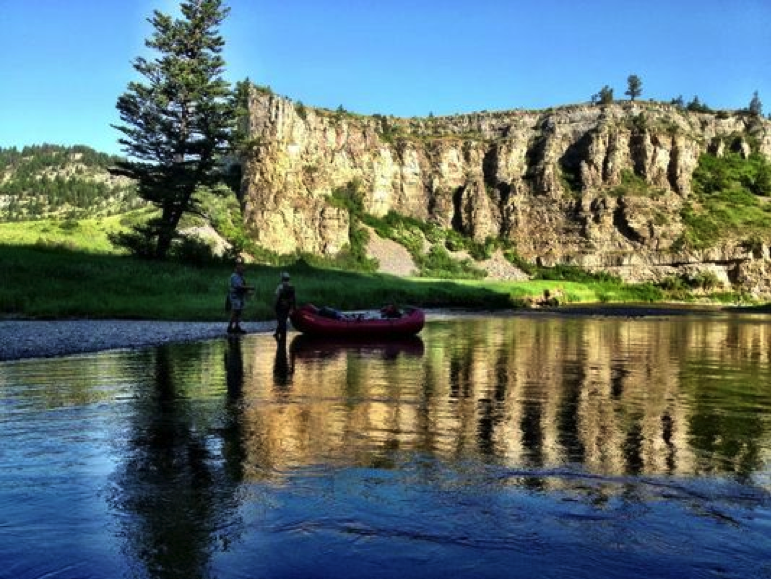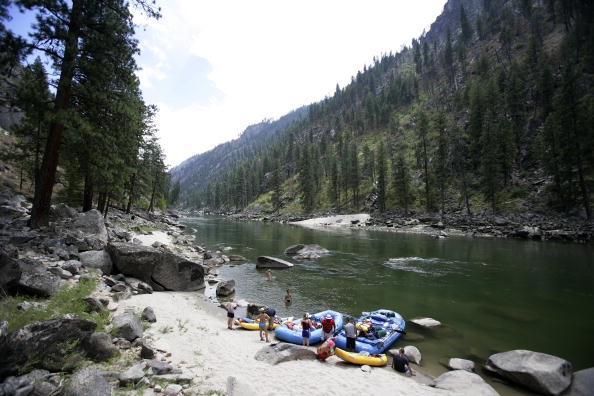Community Choices: White Sulphur Springs and Tintina Resources Inc.
By: Valerie SiglerPosted on July 12, 2015 FREE Insights Topics:
Introduction by John Baden
Working with honor students is among the several luxuries of university teaching. My first experience was teaching an economic anthropology Honors Course at Indiana University in 1969. Forty-six years later I'm privileged to work with Valerie Sigler, an MSU Honors College student. This summer we are working at the confluence of ecology, economy, and hydrology.
This is another enjoyable exercise in economic anthropology applied to natural resource policy. Economics focuses on information and incentives while anthropology studies how culture affects incentives. For example, American culture places large negative incentives on cruelty to animals, positive incentives for kindness to them.
Culture includes the constellation of taste, values, and constraints. It provides the context for policy decisions. Culture involves shared patterns of behaviors, personal interactions, social arrangements, and the understanding people learn through socialization.
Culture becomes a group identity learned through social patterns of the group. Thus, for example, the Hutterian Brethren on the Northern Plains have a culture distinct from their gentile Montana neighbors. Bozeman ice climbers, kayakers, and other “fun hogs” are yet another.
Trout Unlimited is a conservation group focused on protecting and restoring the habitat of cold-water fisheries. Members come from several sub-cultures but most have high education and income. Ninety-six percent of TU members are male; 78% have college educations with 40% holding master’s or doctorate degrees; and 49% of members have household incomes exceeding $100,000 a year. Few of them need worry about affording propane for modest houses or doublewides.
Their situations are markedly different from those hoping to become well-paid working class people in small rural towns, hard-rock miners in this case. This week's FREE Insights is by Valerie Sigler, a geology student in MSU's Honors College. Her column addresses a resource management conflict driven by cultural and economic factors. The potential copper mine site is next to a tributary of the Smith River in central Montana, one of North America's finest trout streams. Her case well illustrates the roots of many natural resource conflicts. They necessarily involve culture, ecology, and economy. One of the lessons is that there are no cost free solutions. Tradeoffs among competing values must be made in all such situations.
Community Choices: White Sulphur Springs and Tintina Resources Inc.
Surrounded by three mountain ranges (Big Belt, Little Belt, Cascade) and located in the geographic center of Montana, the White Sulphur Springs area has been a thoroughfare for centuries. Native Americans revered this valley for its healing springs known as “Wampum Waters.” They annually trekked through this neutral territory to reach summer hunting grounds.
When James Brewer built the first cabin in the Montana Territory at Trinity Springs in 1864, the Flathead Indians told him of the magical springs in the Smith River valley. Brewer promptly moved, opened up a bathhouse ($.75 per bath, whiskey extra) and a "hotel" of dirt roofed log cabins. Twelve years later, in 1876, Dr. Parberry bought the area from Brewer, changed the name to White Sulphur Springs, and established a post office.
A short time later, in 1880, the growing town became the county seat in Meagher (pronounced “Mar”) County. Eight years later, 1888, White Sulphur Springs incorporated. The municipal water supply was built in 1897. By 1898, White Sulphur Springs was a bustling town with 800 people, one large store, two drug stores, a couple of saloons, two livery stables, one harness shop, one meat market, a newspaper, and two banks. The public sewer was added in 1916.
(https://archive.org/stream/comprehensivepla1981meagrich/comprehensivepla1981meagrich_djvu.txt )
Through the years, mining, agriculture, and logging have dominated the commerce of White Sulphur Springs. Small towns dependent upon a single industry suffer dramatic economic difficulties when technology and resources change. When the lumber mill closed in the 1980s, White Sulphur Springs, Montana endured economic setbacks that have lasted over three decades, dropping the population by 30% from ~1400 to ~970.

White Sulphur Springs, www.a-drifting-cowboy.blogspot.com
With Tintina Resources Inc.’s plans to build a copper mine in the area, White Sulphur Springs’ industry has come full circle back to mining. White Sulphur Springs teeters on the precipice of decision as it weighs the pros and cons of having Tintina Resources Inc., a Canadian company, develop a copper mine close to Sheep Creek, a tributary to the famous Smith River.
Certainly, White Sulphur Springs’ economy has been depressed in since the lumber mill closed decades ago. Potentially, the mine could infuse the town with approximately 200 employment opportunities, greater increased income, and rising revenues. The initial phase of the mine could last approximately 14 years. According to Hieth Stidham, president of White Sulphur Spring’s City Council: “The support of the public is absolutely phenomenal.”
The public support Hieth Stidman refers to is the local enthusiasm of those who will, directly and indirectly, benefit from jobs. Many environmentalists, especially trout fishermen, are concerned about the potential environmental impacts of a mine located where it could inflict long-term damage to the hallowed Smith River. The proposed mine is located one mile from Sheep Creek, which is a tributary for the Smith River. Mark Aagenes, Trout Unlimited’s conservation editor, explains the importance of Sheep Creek: “Sheep Creek provides the Smith with clean, cold water and it’s critical, critical spawning habitat. Making sure that Sheep Creek stays healthy is very important to us.”
The Smith River originates in the Castle Mountains, then flows northwest through the valley between Big Belt and Little Belt mountains, past White Sulphur Springs and past the Smith River State Park. Eventually it joins the Missouri River nine miles southwest of Great Falls.
The Smith River is treasured by anglers for its premier trout fishing; adored by rafting enthusiasts for its 59 mile stretch of river, interrupted by only one public access; and cherished by nature lovers for its spectacular scenery. The Smith River is considered a “Red Ribbon” trout stream, home to rainbow and brown trout, as well as whitefish. Rafters lucky enough to obtain a permit in the annual lottery encounter four days of sheer rock walls, rocky shallows, sharp turns, class II whitewater, and swirling eddies.
The Smith River exemplifies Montana’s stellar rivers.

Smith River, www.greatfallstribune.com

Smith River, www.mooseradio.com

Tintina Resources’ proposed mine may benefit 200 employees, their families, local businesses and suppliers but thousands of people recreate, fish, and enjoy the Smith River Valley for its pristine beauty each year. The copper mine’s resources have an estimated limited life of fourteen years. Yet, the Smith River Valley has long been revered for its wildlife and beauty.
While Tintina Resources, Inc. are submitting forms and conducting environmental tests, conservation groups rally to protect the precious Smith River. Leading the charge is Trout Unlimited, a conservation group organized in 1959. Members of Trout Unlimited, TU, have the money, connections, and education to mount a substantial campaign. Ninety-six percent of TU members are male; 78% hold college degrees; 40% hold master’s or doctoral degrees; 59% work in a professional or managerial positions; and 49% have a household income exceeding $100,000.
People who have healthy incomes, discretionary money, and ample time to pursue hobbies often devote themselves to environmentally “green” projects. They have the capacity to support their projects with energetic, morally supported, persistence. In contrast, those who struggle to pay their monthly bills usually lack the time, energy or discretionary funds to donate to conservation causes. When a company, such as Tintina Resources, Inc., promises a transition from poverty to prosperity, locals welcome the promised opportunity.
Here is the key question: “Is the price of a short-term gain, perhaps only fourteen years, worth the long term damage of America’s prized Smith River? We know some damage from mines lasts for centuries, even millennia.
In 1981, White Sulphur Springs adopted a Comprehensive Plan. The citizens filled out an extensive questionnaire defining goals for the town. The top items were: more jobs, more places to shop, and more recreational facilities. One of the goals was “to encourage a mix of employment opportunities that will lessen the impact of high unemployment due to the seasonal nature of agriculture, forest products, and recreation industries.” To assist in this goal, citizens recommended developing businesses and industries that would employ locals. An addendum stated: “Examine and be selective in endorsing any industrial or commercial activity that may wish to locate in the area.” And most importantly, the Comprehensive Plan continues, “Encourage those industries which have no adverse effect upon the character and natural environment.” (emphasis added)
https://archive.org/stream/comprehensivepla1981meagrich/comprehensivepla1981meagrich_djvu.txt
Since the survey was completed, the lumber mill and numerous other businesses have closed. After decades of a declining economy, White Sulphur Spring’s community members value the short term gains over potential long term environmental degradation. While wealth, education, and environmental sensitivity normally go together, in this case the converse applies. Relatively poor people favor a more prosperous economy over ecological sustainability.
In Montana, a Mine Operating Permit (MOP) must be issued and a reclamation bond in place before construction of the mine begins. After a MOP is applied for, an Environmental Impact Statement (EIS) is initiated. The EIS includes a review period with the Department of Environmental Quality (DEQ) which includes opportunities for public comment. If the MOP is approved, Tintina Resources, Inc. expects construction to be begin within 24 months. In May 2015, Tintina Resources Inc., submitted their results of the aquifer test to Montana Department of Environmental Quality. Details about the test can be found on their website: http://www.tintinaresources.com/i/pdf/nr/TAU-NR-May-21-2015.pdf
In an effort to protect water resources, Tintina plans to locate the mine portal, mill, and tailings repository at least one mile from Sheep Creek and separated from the valley by a large hill. Water (and its contaminants) seep and flow. Is a mile far enough? On Tintina’s website, www.tintinaresources.com, the company outlines the procedures they will use to protect water resources. I am not a hydrological engineer so I am not qualified to determine if these will be effective enough to offer ZERO risk of contamination. Montana is littered with towns devastated by mining. Environmental disasters scar beautiful landscapes because even with extensive precautions and good intentions, accidents happen.
Tintina Resources declares on their website (www.tintinaresources.com) to have an: “open door policy;” “a commitment to be “transparent;” and “to do the job right during exploration activities, operations and reclamation with respect for all people and the environment.” Promises of “the technology is better now”; “environmental impact tests are being done”; “there is very little risk with today’s methods”; and “we care about the environment too,” are common from Tintina Resources, Inc.’s officials. Many White Sulphur Springs’ residents believe them. Of course, they do. They have strong incentives to do so. However, all of the good intentions and comforting words in the world cannot “put the toothpaste back in the tube” when accidents and contamination occur.
Aspirations to live the “good life,” vary depending on one’s perspective. A comparison of the vision of the good life between those hoping to preserve Sheep Creek/Smith River and those hoping Tintina Resources, Inc. will elevate the town’s economy reveal two contrasting cultures with very different goals. Citizens of White Sulphur Springs, whose income per capita is $18,334, may view Tintina Resources as a vehicle to the good life. However, wealthy, well educated people who revere natural beauty consider conservation a priority to the good life, especially when their wellbeing is totally independent of mining jobs. The tradeoffs between increased prosperity and ecological risk are weighed differently between the two populations.
These are the roots of conflict over natural resource policy.
TECHNICAL APPENDIX:
Montana has SEVENTEEN Superfund Sites, nine of them related to mining.
DATE LISTED | COUNTY | NAME | REASON |
3/2011 | Cascade | Anaconda Copper Mine, Smelter, and Refinery
| Soil and surface water contamination by arsenic, lead and other heavy metals. |
9/2009 | Mineral | Flat Creek IMM | Soil, groundwater and surface water contamination by arsenic, antimony, lead and manganese from mine tailings, some of which was used as fill and construction material in the nearby town of Superior. |
9/2001 | Cascade and Judith Basin | Barker Hughesville Mining District | Ground water, sediment, surface water, and soils are contaminated with metals including zinc and arsenic. |
9/2001 | Cascade | Carpenter-Snow Creek Mining District | Groundwater, soil and watercourse contamination by arsenic and heavy metals. |
10/1999 | Jefferson | Basin Mining Area | Mine wastes contaminated Basin and Cataract Creeks and the soils within the town of Basin. Contaminants include arsenic, cadmium, copper, lead and other metals. |
10/1999 | Lewis & Clark | Upper Tenmile Creek | Heavy metal and arsenic contamination from mining. |
9/1983 | Deer Lodge | Anaconda Copper Mine, Smelter, and Refinery | Soil and groundwater contamination by arsenic, copper, cadmium, lead and zinc. |
9/1983 | Missoula | Milltown Reservoir Sediments | Groundwater and reservoir sediments contamination by arsenic and copper from historic mining activity. |
9/1983 | Silver Bow | Silver Bow Creek/Butte | Groundwater, surface water and soil are contaminated with arsenic, copper, zinc, cadmium, and lead from mining and smelting. Silver Bow Creek and the Clark Fork River contain metals from the cities of Butte to Milltown. Mine tailings in the creek and river have caused fish kills in the river. |
